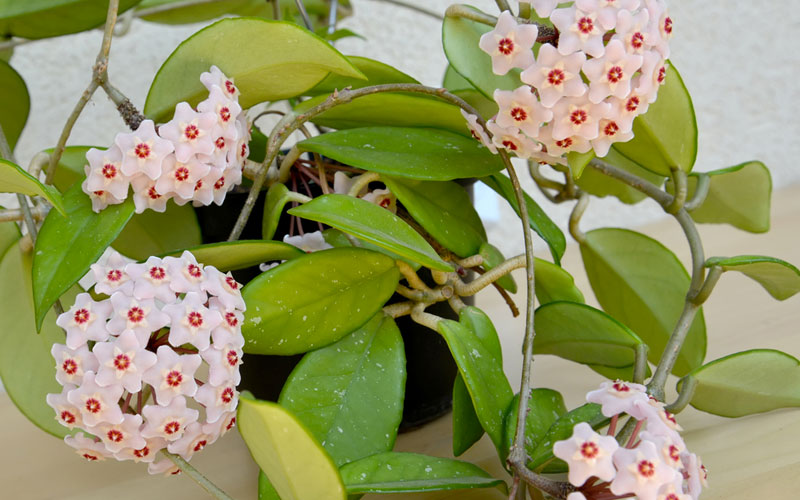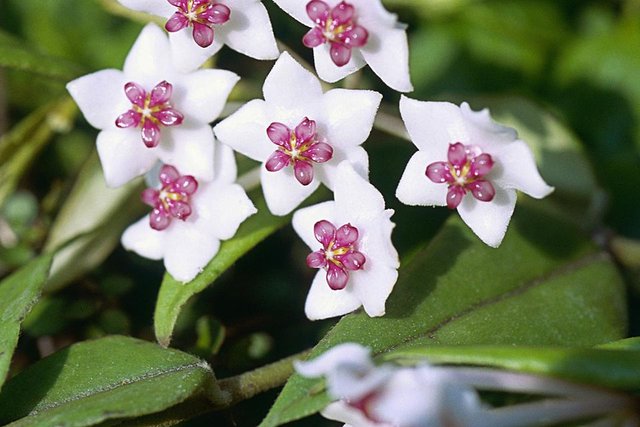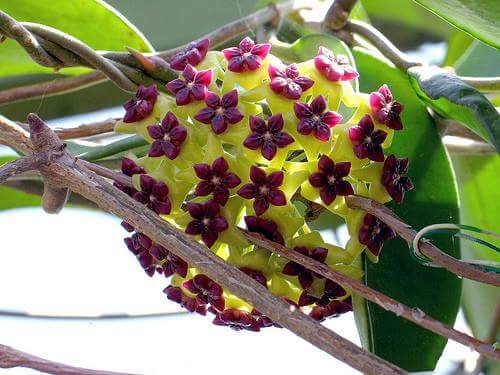All hail the Hoya.
The Hoya ( common name is Waxflower ) is a climbing plant for temperate and warm climates. There are quite a few species, but all have colourful waxy flowers and waxy thick green leaves. The Hoya can be grown outside in a suitable spot preferably out of the full sun, but in a spot that gives the plant lots of natural light, as it flowers well in these conditions. I have grown Hoyas successfully in a position with morning sun, and good light throughout the day. The plants need a well drained soil, and don't mind being potbound with their roots restricted. They are epiphytes and grow naturally in places like tree canopies, in the forks of trees where they survive on rainfall and leaf litter from above. Hoyas flower from the same flower nodes each year, so be careful not to cut the nodes off !!
This Hoya was photographed growing on the balcony of a Sydney apartment.
General tips for all Hoya Plant Care
Hindu Curly Rope Hoya
The Curly Rope Hoya is a harder-to-find carnosa.
Never cut the long tendrils! Leaves and flower clusters develop from these.
Propagate Hoya plants from stem cuttings or by air layering.
Hoyas don’t mind being a bit root bound. Keep in the same pot for years, but remember to fertilize throughout spring and summer.
All Hoyas need to be potted in planters with drainage. These plants are very sensitive to too much water, so be sure to use a well draining soil with plenty of pumice and/or perlite.
Hoya carnosa, the porcelainflower or wax plant, is an Asclepiad types of blossoming plant in the dogbane family Apocynaceae. It is one of the numerous types of hoya that are local to Eastern Asia and Australia. It is a typical house plant developed for its alluring waxy foliage, and sweetly scented blooms.
Despite the fact that numerous swear Hoya plant mind is among the most effortless of every single indoor plant, we've looked after numerous Hoyas in the nursery throughout the years, and have discovered that every ha its particular preferences. Here are 5 of our most loved Hoya cultivars and their care prerequisites. We'll travel through from most to slightest normal, so you can ace the intricate details of Hoya plant mind. Furthermore, we'll share a tip to initiate blooming.
The blooms are normally light pink, yet may differ from close white to dull pink; they are star-molded, and are borne in bunches that resemble modest wax miniatures. The surface of the blossoms is canvassed in minor hairs giving them a fluffy sheen. They are intensely scented and may deliver abundance nectar that dribbles from the blossoms. Like all Hoyas, this species blooms from particular perpetual structures alluded to as goads. These show up from the axils of the leaves and stem; blooms may not be delivered when the goads initially show up, but rather in time buds rise up out of the tips. Each season new blooms are created on these same goads, so they ought not be harmed or expelled.
H. carnosa has been in development for over 200 years and has offered ascend to numerous cultivars that change in foliage shape or bloom shading. In development in the UK it has picked up the Royal Horticultural Society's Award of Garden Merit.
Late investigations at the University of Georgia have indicated H. carnosa to be a fantastic remover of toxins in the indoor condition.
https://images-na.ssl-images-amazon.com/images/I/51F9BpI4ryL.SX355.jpg
Congrats, you won the Silly Sausage Award for your comment. Great pics and info. Well done !!
Native to southern India, highly prized, and the subject of legend. You’ll find Hoyas throughout eastern Asia to Australia and classified botanically in the asclepias (milkweed) family. The exact number of species is a mystery. Bailey’s Standard Cyclopedia of Horticulture estimates there are 100 species. Listed at the end of the article are over 550 recoginized species. The most common species, and the one most often seen and grown as a houseplant is Hoya carnosa and Hoya carnosa variegata.
In a sunny window the foliage is unusually decorative, and their late spring and summer flowers are highly prized. Some consider Hoya blooms among the most exquisite creations of nature, seemingly fashioned from ivory or porcelain, with glimmering centers of ruby and amethyst. The blossom of Hoya carnosa carries a delicate, elusive fragrance which is barely noticeable. The waxen ball of five-pointed, double stars, is geometrically perfect; giving the bloom an artificial look. Those experiencing Hoya carnosa for the first time are pleasantly surprised to find it is real.
Details found via : https://plantcaretoday.com/hoya-plant-care.html
Congrats, you will share the Fav. comment Award with one other. Nice pics of Hoyas and good info. Well done !!
Thank you very much @ctrl-alt-nwo.
The name “Hoya” honors Thomas Hoy, gardener to the Duke of Northumberland and the first to bring this superb house plant into prominence.
The exact number of species is a mystery. Bailey’s Standard Cyclopedia of Horticulture estimates there are 100 species. Listed at the end of the article are over 550 recoginized species. The most common species, and the one most often seen and grown as a houseplant is Hoya carnosa and Hoya carnosa variegata.
Thick leaves of green, rimmed with red and white, and a waxen texture from which it derives the nick-name “wax plant.”
Some consider Hoya blooms among the most exquisite creations of nature, seemingly fashioned from ivory or porcelain, with glimmering centers of ruby and amethyst. The blossom of Hoya carnosa carries a delicate, elusive fragrance which is barely noticeable.
Source
Congrats, you will share the Fav. comment Award with one other. Nice pics and good info. Well done !!
Has Fav. Comment reduced to 15%?
Hoya Plant Information
✦ Plant Type: Evergreen perennial
✦ Growth Habit: Vine (climbing, trailing), shrubs
✦ Other Names: Wax plant, wax flower
✦ Native to: India, China, Thailand, Malaysia, Indonesia, Philippines, Polynesia, New Guinea, and Australia
✦ USDA Hardiness Zone: 10-12
✦ Light Requirement: Sun in the morning hours and bright, indirect light for the rest of the day
✦ Watering: Average; avoid excessive watering
✦ Soil: Well-drained soil; Alkaline/neutral/acidic


op.jpg)
✦ Flowers: Star-shaped flowers that grow in clusters
✦ Flowering Season: Throughout the summer
✦ Colors: White, pink, cream, yellow, orange, etc.
✦ Foliage Color: Green
✦ Other Characteristics: Some species might be toxic to livestock
The Hoya plant, also known as the Hindu Rope or Wax plant, has been enjoyed for years and is very popular among many home gardeners. It's a vining plant with thick, waxy looking leaves and can produce beautiful flowers. Many people like to grow them in hanging baskets. The Hoya plant has wheel-like clusters of porcelain or waxy flowers. The flowers typically have stars in their crowns and often produce a unique, enjoyable fragrance.�
Light: Bright indirect light year-round. Hoyas will live in low light, but will not bloom. It's also important to give them darkness at night. Plants need a rest, too. Once your plant has formed flower buds, don't move it around. Changes in light levels can cause flower buds to shrivel up or fall off before they open.
Water: Water spring through fall, allowing soil to dry out a bit between waterings. Flowering Hoya plants are thirsty, but don't like to sit in soggy soil. Use room-temperature water for your tropical plants. Cold water can shock them. In winter, water sparingly giving the plant just enough to keep the soil from drying out.
Fertilizer: Feed monthly spring through fall with an organic, diluted liquid fertilizer. 🌿🌸💚
Commonly Grown Hoya “Species”
Hoya australis – has huge, waxen, deep-green leaves measuring nearly four inches across, and splotched with silver. It is a vigorous, strong grower, vining kind with distinctly fragrant flowers, pink with red crowns.
Hoya bandaensis – Sturdy plant with deep-green glossy leaves.
Hoya bella – is a handsome dwarf, small growing species with slender upright branches that droop down as they age; a non climber, small leaves are thick, dark green; flowers are white with purple centers. An old favorite. thanks to sharing for your valuable post of hoya plant..very well done..my dear friend.. @ctrl-alt-nwo
thanks to sharing for your valuable post of hoya plant..very well done..my dear friend.. @ctrl-alt-nwo
Very nice pics !!
thank you my dear friend.your encouraging word may very quickly success in my future... again thanks for your great work..my dear friend @ctrl-alt-nwo take care yourself...
The genus Hoya was named by Robert Brown, a Scottish botanist and palaeobotanist who is well-known for his contributions to the field of botany, especially plant taxonomy. This genus comprises more than 200 species of tropical plants. Several species belonging to this genus produce beautiful, sweet-scented flowers that appear in clusters. Though many species are twining vines, some might grow as shrubs. Some of the species can be epiphytes. Epiphytes should not be mistaken for parasitic plants. Though epiphytes grow on other plants, they get nutrients and moisture from air and rain. There are some species that start as terrestrials but turn into epiphytes later.
Hoya plants are also referred to as wax plants, wax flowers, or wax vines due to their waxy foliage and porcelain-like blooms. When cut, clear or milky sap oozes out. While gardening enthusiasts might marvel at the variety of blooms that the different varieties or cultivars offer, some of the varieties also produce ornate leaves. For instance, Hoya kerrii, which is called the Sweetheart Plant or Sweetheart Hoya, is popular due to its heart-shaped leaves.
Hoya Plant Information
✦ Plant Type: Evergreen perennial
✦ Growth Habit: Vine (climbing, trailing), shrubs
✦ Other Names: Wax plant, wax flower
✦ Native to: India, China, Thailand, Malaysia, Indonesia, Philippines, Polynesia, New Guinea, and Australia
✦ USDA Hardiness Zone: 10-12
✦ Light Requirement: Sun in the morning hours and bright, indirect light for the rest of the day
✦ Watering: Average; avoid excessive watering
Very popular among gardening enthusiasts, Hoya carnosa has thick, glossy leaves that are about 6-10 cm in length and 4-6 cm in width. The plant can grow up to a height of 15 feet. Its popularity is often attributed to its sweet fragrance. Each umbrel has about 20-30 flowers.
If you remember a vine creeping around your grandmother’s kitchen, chances are it was a Hoya plant. This tropical indoor plant — often called a “Wax plant” due to its thick waxy leaves — is a classic because it lives forever, grows to be enormous, and creates beautiful, porcelain-like fragrant flower clusters (it’s also often called “Porcelain flower”).
Hoya (family Asclepiadaceae) A genus of twining and root-climbing plants that have fleshy leaves and flowers which are waxy, highly fragrant, showy, and borne in umbels. They are delightful hothouse ornamentals. There are about 90 species, native from southern China to the Pacific.
The Hoya must be mature (3+ years old) in order to bloom! It will need bright diffused light at the very least, but as stated above, a bit of direct sun is beneficial. If age and light are on your side, you can also encourage flowers by keeping your Hoya in a snug pot and not disturbing the roots too much. And of course, don't cut those peduncles! Once in bloom, absolutely do not repot, mist the plant, or move it around often, or it will be more likely to drop it's blooms. Given the right conditions, your Hoya is likely to provide you with nectarous blooms year.
Source:https://www.stamenandstemblog.com/blog/hoyacarnosa
Hoya the beautiful flowers which is commonly known as waxflower. Mainly hoya is an ancient greek and used in certain Biblical quotations.
source
The flowers are light pink and white to dark pink. It's the flower of Australia, Asia including India, China, Thailand, Malyaysia, Viet Nam, Indonesia and Philippines.
source
source
Flowers is the beauty of nature and i love flowers. We can learn many things from flowers like purify our mind, pure love and peace.